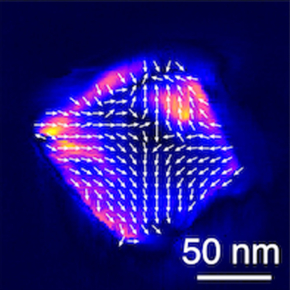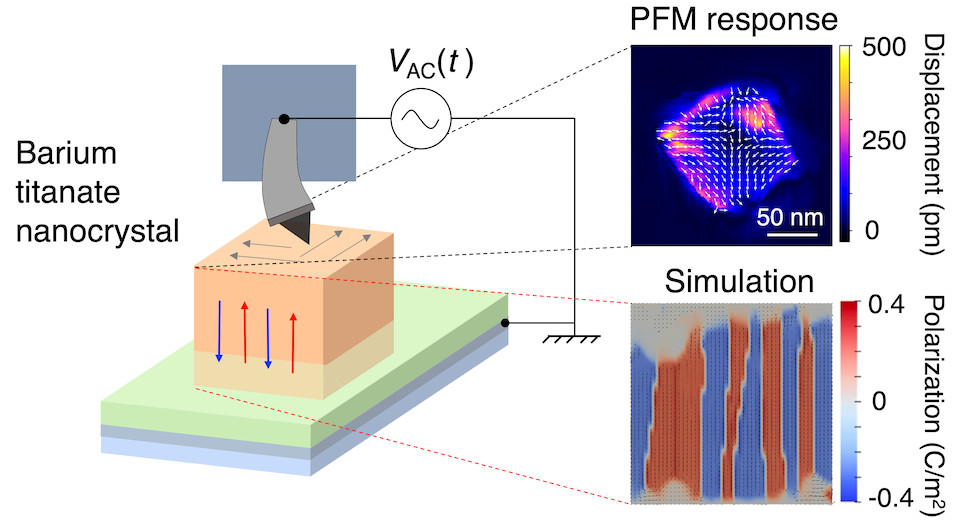Teams from French laboratories, including SPEC/LEPO, and American laboratories have pooled their know-how to study experimentally and theoretically the ferroelectric structure of cubic barium titanate (BTO) nanocrystals. These results, published in the journal ACS Nano, open the way for new designs in optical and thermal nanosensors.

At the nanoscale, ferroelectric materials exhibit polarization structures that can be complex, and can be used to reduce the energy consumption of electronic components. The vast majority of studies are focused on thin films of these materials.
A collaboration of French and American teams has studied BTO nanocrystals (nanoBTO) synthesized in a cubic form, with an average size of ≈160 nm. The ferroelectric “texture” of these nanometric objects was probed using piezoelectric force microscopy (PFM). This measurement technique uses a tip as a local probe in contact with the sample, and takes advantage of the crystals’ multiferroic character, both ferroelectric and piezoelectric. In parallel, simulations of the equilibrium electrical polarization distribution and PFM response were carried out using a phase field model (FERRET module).
Measurements reveal that the facets of all the nanoBTOs studied have a in-plane PFM (local deformation) response to an electric field applied perpendicularly. Phase-field modeling helps to explain this observation. It reveals that the equilibrium polarization, consisting mainly of alternating up and down domains (aligned along one crystallographic axis of the BTO tetragonal phase), rotates by 90° at facets orthogonal to this axis. The simulation also provides a qualitative account of the deformation fields measured by PFM.
Published in ACS Nano, this work highlights the interest of the PFM technique and opens the way to the design of optical nanosensors (temperature or electric field measurement sensors, for example) based on nanoBTOs doped with rare-earth ions.
The results of the study also raise the question of the origin of the nonlinear second-harmonic generation (SHG) optical response of individual BTO nanocrystals widely described in the literature. Indeed, given the ferroelectric texture revealed in the simulations, the nanocrystals appear to be made up of core and surface domains oriented at 180° to each other, with overall polarization compensation. A priori, this should result in the absence of SHG by destructive interference, which is not experimentally observed. Further analyses coupling PFM and SHG will be carried out in the near future to gain a deeper understanding of the structure of these nanocrystals.

Electrical polarization of a ferroelectric nanocrystal: study by piezoelectric force microscopy (PFM) and phase-field model (simulation).
Left: stacking of a ferroelectric BTO nanocrystal (orange) on a thin layer of conductive polymer (green), deposited on a conductive deposit (gray-blue) covering a glass slide. An alternating potential difference is applied between the PFM tip in contact with the top and bottom faces of the nanoparticle.
Right, top: amplitude (color code) and direction (arrows) of displacement of the PFM tip in response to the alternating electric field.
Right, bottom: simulation (phase field model, FERRET module) of the electric polarization in the vertical plane in the middle of the nanocrystal, showing the domain structure of alternating polarization orientation (along one crystallographic axis direction), as well as the absence of vertical polarization in the lower and upper faces, in agreement with PFM measurements.
© F. Treussart, C. Paillard and C. Fiorini
Reference:
Ferroelectric texture of individual barium titanate nanocrystals.
Athulya K. Muraleedharan, Kevin Co, Maxime Vallet, Abdelali Zaki, Fabienne Karolak, Christine Bogicevic, Karen Perronet, Brahim Dkhil, Charles Paillard, Céline Fiorini-Debuisschert, and François Treussart, ACS Nano 18 (28) (2024) 18355
See in HAL et Arxiv open-archive publication (follow the link)
See also the CNRS-Ingeenering highlight: “De nouvelles données récoltées sur la texture ferroélectrique de nanocristaux individuels de titanate de baryum“.
Contact CEA-IRAMIS : Céline FIorini, SPEC/LEPO
Collaboration:
- Université Paris-Saclay, Laboratoire lumière-matière aux interfaces (LUMIN), UMR CNRS/ENS Paris-Saclay, Université Paris-Saclay,
- Laboratoire Structures, propriétés et modélisation des solides (SPMS), CentraleSupélec,
- Université Paris-Saclay, Laboratoire d’Électronique et nanoPhotonique Organique, Service de Physique de l’État Condensé – SPEC, UMR CEA-CNRS,
- Département de physique de l’Université d’Arkansas aux États-Unis.

